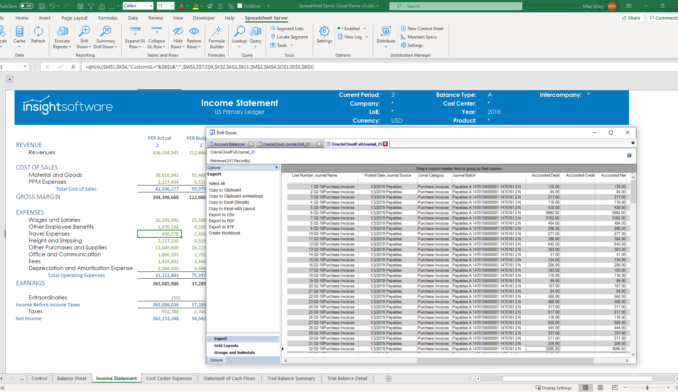The term business intelligence (BI) was coined several years ago when software tools enabled dashboards and “drill down” into data, such as viewing line items in a customer’s invoice. It primarily involved and was restricted to reporting. It described what happened. But now managers and analysts are interested in answers to “what can happen.” And they want to know the impact of future projections. This takes BI a step up to business analytics (BA) with a forward-looking predictive view.
We’ve often been told that looks are not everything. But sometimes, looks do matter. Information needs to be displayed in ways that quickly provide interpretation and insights. One of the more important developments in 2018 will be further advances with real-time visualization with BA. As mentioned, BI tools initially satisfied business users’ demands for better visibility. But those same users are now realizing that BI dashboards stop short of delivering ultimate business value.
In the coming year, organizations will invest in BA—interactive, real-time data visualization—to make sense of vast data stores to uncover insights and explore scenarios and potential outcomes. These solutions will replace static (but pretty) graphical representations of key information and make it easy for business users to quickly view live, accurate data in an easy-to-understand format.
Summer of Reckoning: Data Governance and Curation
For organizations and enterprises relying on traditional financial performance processes supplemented with business intelligence platforms, a need for expanded IT involvement may progress, thus leading to an emerging concept in 2018 around data governance and curation. The IT function has been involved for decades with data governance, typically with large legacy software systems. IT has not paid much attention to individuals in their organization creating and sharing their own files, such as static spreadsheets. That will soon end. IT looked the other way when users purchased business intelligence (BI) software that was priced just below the procurement policy threshold requiring a higher level manager’s approval. But now as leveraging big data begins to emerge as a competitive advantage, the existence of multiple and disparate BI software vendor products imposes the same threats and complications that data governance addressed decades ago. The reason we added “and curation” is because so much of today’s big data comes from external resources. That is, big data does not exclusively come from an organization’s internal data. So, similar to a curator in a museum who is also responsible for art work that is loaned to the museum for display but not owned, curation will be added to data governance.
Benefits from Business Analytics
Today managers and analysts are very busy with many priorities. Their time to analyze information is limited. It is cumbersome for them to interpret stacks, columns, and rows from a table data. Additionally, viewing visuals of dated data offers no true value to proactively optimizing business objectives. They want interactive and real-time pie charts, histograms, and other graphics to show potential outcomes from changes to independent input variables. They want to be enabled to make better, quicker, and more informed decisions.
With BA, users are able to change input independent variables, such as forecast sales volume—often with a slider cursor on their computer or mobile device—and then immediately view the impact from the re-calculated results. In this specific example of sales volume forecasts, the real-time calculated result would be the changes in profits, need for more or less labor, materials, and other resources.
In 2018, many organizations will look to solutions to expand on BI. Some will host the solution in-house, which can burden IT and be costly. Others will consider cloud-based solutions, which are usually faster, easier to implement, and less costly to manage and update.
Smarter Implementations of Enterprise and Corporate Performance Management (EPM/CPM) Methods
In 2018 there will be increasing implementation and integration of enterprise and corporate performance management (EPM/CPM) methods. (EPM and CPM are synonymous. Public sector government agencies and not-for-profits prefer the former term.) Each method will be embedded with advanced analytics of all flavors. Collectively the EPM/CPM methods will leverage operational transaction data by converting the data into information—including financial information—to improve the organization’s performance.
Organizations will have seamless integration of the tools, methods, and systems to support organizational objectives. I predict organizations with disparate systems and varying methods to achieve the same objectives will have little choice but to unify and integrate them. The reason is because many organizations continue to use methods from decades ago when more advanced ones now exist. Progressive methods provide a competitive advantage. In many organizations, they are disconnected and implemented in isolation from the other methods.
An integrated methodology would leverage EPM and CPM methods. Examples of EPM/CPM methods are:
- Strategy execution with a strategy map and its companion balanced scorecard (KPIs) and operational dashboards. With metrics that increase accountability of managers, it aligns their actions and priorities with the C-suite executive team’s strategy.
- Enterprise risk management (ERM). The expenses for risk mitigation of potential risk events can be included with the budget; they are often excluded.
- Capacity-sensitive, driver-based budgets and rolling financial forecasts. Modeling projected expenses based on cause-and-effect relationships is superior than consolidating cost center spreadsheets that are prone to gaming (e.g., padding) and volume insensitive.
- Product, standard service line, channel, and customer profitability analysis (using activity-based costing [ABC] principles). Companies need much greater accuracy to know where they are making and losing money and by how much. They need to know which types of customers are more attractive to retain, grow, win-back, and acquire.
- Alerting capabilities. Feedback signals notify managers when reported results are above or below expected thresholds.
- Lean and Six Sigma quality management for operational improvement. Productivity increases and cost management are vital for sustaining any organization’s viability.
As mentioned above, business analytics of all flavors will be imbedded into each of the EPM/CPM methods. These analytics will turbo-charge integrated EPM/CPM. Types of analytics will include correlation, segmentation, and regression analysis, and especially predictive analytics with prescriptive analytics—optimization—as the highest form. A more forward-looking approach to performance management will lead the way, enabling a company to “out smart” their competitors and better serve their customers and stakeholders.
In summary, 2018 will be a time for business leaders across all industries to adapt, optimize, and ideally achieve the results they want.







